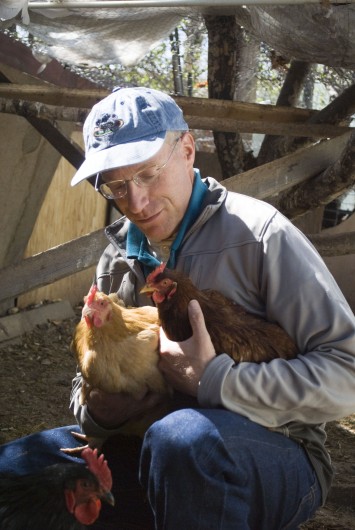Spines 2: To and From The Editor
Dear JSE Readers,
As we enter into our second year, I continue to be moved, and even overwhelmed, by the level of interest in the future of humanity….and how that future can be made more sustainable… and how education can contribute to that process.
I am every day made more humble by this job, of reading great writings, coming to new understandings that others bring, and trying to sort and group ideas in a way that makes sense, and that is helpful to you, our readers. I wish I could say that it becomes easier, but the truth is that, ironically, the longer I call myself the editor of JSE—that is the Journal of…Sustainability…Education—the more I am hard-pressed to say what exactly “sustainability” is and exactly how “education” about it happens. Nonetheless, what raises my spirit daily is the hope and confidence and aspirations that our authors bring to the endeavor.
The pages…no screens… of our journal reflect the dedication of educators of every stripe, discipline, style, background and venue to change what happens next in a way that will improve human quality of life, and improve the environments—economic, social and ecological—in which we live. And I suppose those simple phrases which jump off my keyboard are as close as we can come to what this is all about: “change what happens” in a way that “improves human quality of life.” Does the term “education” encompass all the ways in which we strive to bring about change? And does the word “sustainability” wrap up the many milieus and levels at which we strive to improve quality of life? While I remain pensive and worried about these ultimate questions, our authors have come through again, plunging ahead in their various disciplines with real and great ideas that we can take home and use. Doesn’t matter if you call what you’re striving for “sustainability.” Doesn’t matter if the way you’re trying to get there is called “education.” What matters is that we enhance life fulfillment and that, as guest editors Terril Shorb and Pramod Parajuli put it, we “call learners to a higher purpose” and create a “fecund and relational social landscape where people feel they belong to something great.”
Of course you’ll find your way through the bits by dropping down the menus and rolling the Search Box, and I would hate to qualify which are the best of our contributions because they all show the passion and insightfulness and communicativeness of our authors. But if nothing else, part of a fulfilled life is having favorites, so here are a few of mine from this edition of JSE:
Timothy Clayton questions how far organizations can take their “new paradigms” and the ways in which change can be constrained by the systems within which we must function.
Viniece Jennings calls for a deep examination of why so little of sustainability thinking makes it the highest graduate levels of education.
While the architecture and design crowd shows us that they are bringing sustainability principles into every aspect of what they do. Christopher Haines gives an overview of how integral sustainability is to architecture; Peter Papesch and colleagues give us the details regarding building design; and Jane Nichols and Erin Adams shows us a deep example of sustainability in the interior design curriculum.
Char Miller and Bowen Close show us how faculty and campus sustainability coordinators can collaborate, and students can out-perform everyone’s expectations, with a great case study for a nascent course that changed waste management on campus.
Our scholarly features are united by a grander vision of how sustainability education can be framed and implemented. Some, like Erin Frisk and Kelli Larson start with fundamental principles while others, like Kirk Atkinson and Phillip Coleman focus on the practical details such as the effect of online access on the sustainability of educational systems.
Finally, the debate over outdoor education’s widespread adoption of LNT (Leave No Trace) principles is just heating up with Adrienne Cachelin and her colleagues’ fascinating deconstruction. Look for more on this in the future.
As you navigate our treasures, please leave some comments so our authors know what you think, and so that we all know how to keep on making what we publish better and more useful. If you like what you find and would like us to help secure a sustainable future for JSE, please consider donating on an individual level, or considering an institutional sponsorship. You’ll find the boxes for doing this in the right column of the home page.
Stay tuned for our next steps which will include more interactivity via frequent blog-style updates and insights, along with an online community space for developing ideas with geographically distant collaborators, eventually bringing them to fruition, hopefully with formal publication in the JSE.
Thanks, as always, to our great Advisory Board, and our staff—Aimee de Chambeau, Marieke Slovin, and John Gist—who have been unfailing in their great work.
Here’s to the journey,
Larry Frolich
Editor, Journal of Sustainability Education
Biology Faculty, Yavapai College











 Larry Frolich is faculty in Natural Sciences at Miami Dade College's Downtown Wolfson Campus. He is part of the team that is implementing an online Master's Program in Community-Based Resource Management with the Catholic University of Ecuador, Ibarra (PUCE-SI), sponsored by a Fulbright Scholar in Ibarra-Ecuador during the Fall of 2010.
Larry Frolich is faculty in Natural Sciences at Miami Dade College's Downtown Wolfson Campus. He is part of the team that is implementing an online Master's Program in Community-Based Resource Management with the Catholic University of Ecuador, Ibarra (PUCE-SI), sponsored by a Fulbright Scholar in Ibarra-Ecuador during the Fall of 2010. 
